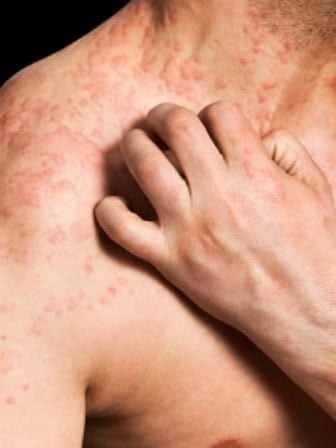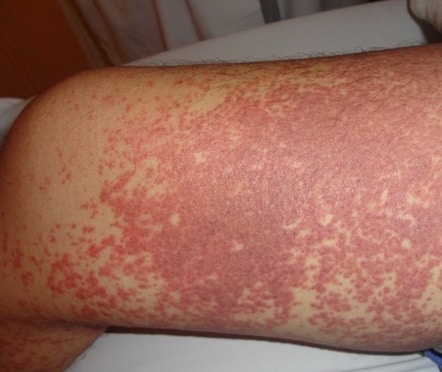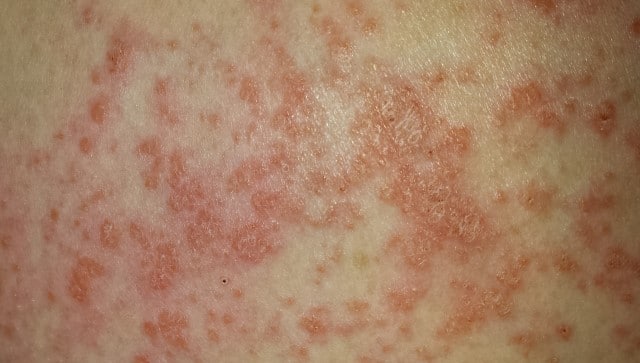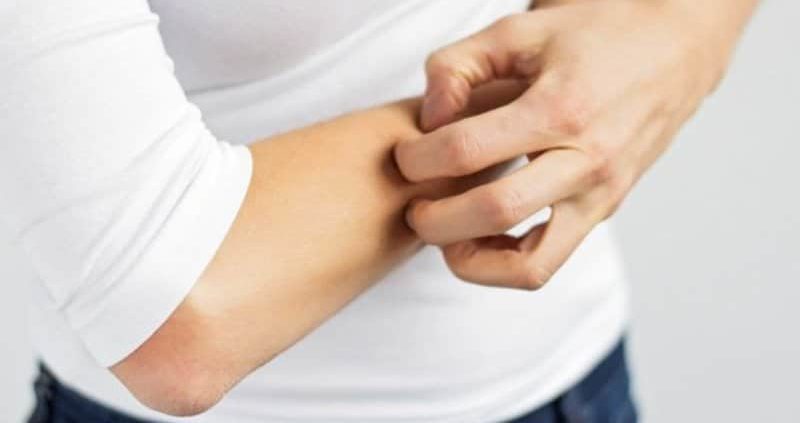If you are taking Lamictal as medication and you are forming rash on your body ,then most likely these are Lamictal rash.
If you are concerned about Lamictal rashes on your body, you are at the right place. Here, you will get to know more about the condition, its causes, symptoms, and treatment.
Well, many of you are familiar with rashes. With such a symptom, the first thing that comes to your mind is an allergy.
But what you should know is; if you are taking Lamictal, it could be a side effect. The rashes range from mild to severe cases.
In severe cases, it may become life-threatening for you. Hence, a better understanding of the condition is the key for you or your loved ones to prevent and treat it.
Now, let’s see the medical Lamictal rash in details.
Table of Contents
Lamictal Rash
It is common to develop a rash if you are taking Lamictal. It is present as hives or red blotchy patches all over your upper body. Sometimes flu-like symptoms are also present. The occurrence of rashes is more common in children than the adult.
Well, Lamictal (generic name: lamotrigine) is an anticonvulsant drug. It is often used as a mood stabilizer for bipolar disorder and epilepsy. Unlike other drugs of this type, it has a black box warning on the prescribing information of rashes that may occur.
And a black box warning is the most severe type of notice issued by the Food and Drug Administration, United States. It means that you are already warned of the chances of death due to rashes.
Not all rashes can be Lamictal rash, but there isn’t a right way to tell. Besides, Lamictal rash presents itself in various forms.
i. The most common is a hypersensitivity reaction which occurs with most medications. It is present as fixed eruptions (like a pimple), an exanthematous rash (as in measles), hives or itch.
ii. The occurrence of a mixed group of different disease-causing non-life threatening rashes. It includes photosensitivity, hair loss, and drug-induced pigmentation.
iii. The most severe and life-threatening rash include Stevens-Johnson syndrome or SJS (10% mortality rate), Toxic Epidermal Necrolysis or TEN (45% mortality rate), severe hypersensitivity reactions, and exfoliative dermatitis.
iv. Finally, worsening of common skin disorders such as acne, psoriasis, seborrhoea and excessive sweating can occur.
Hence, visit your physician at first sight of a rash if you are taking Lamictal.
Causes
The exact cause of the rash isn’t fully understood. But, it is thought that it occurs due unmatched dose or hypersensitivity.
The basic cause behind Lamictal rash is of course one’s sensitive skin; skin by nature might be allergic to Lamictal drug. It can also be due to genetics as some people are more sensitive to it than others.
Another reason may be because of the inability of one’s body systems to adjust to the dose.
In normal cases, the initial dose is ≤25mg and a weekly dose of ≤200mg. So, the rash can be due to high initial dose administering (>25mg) or rapid dose change of the drug.
In addition to this, a drug-drug interaction can occur when a patient uses more than one drug at the time.
If Lamictal is combined with other drugs such as valproic acid, it may increase the rash. People respond to medicines in different ways.
Some may show severe side effects while others only develop mild to no side effects at all.
Along with the dose, the severity of the rash is determined by various external factors.
- Age is a factor. Children are more prone to it.
- If you are taking the medication with valproic acid or sodium valproate, you may have higher chances of rash occurrence.
- Failing to adjust the Lamictal dosage also increases the risk for skin rash.
It is seen that most life-threatening rashes occur within 2 to 8 weeks from the first administration of the drug. There are cases where the outbreak occurs after more prolonged use.
But you must report any rash to your doctor, regardless of the time you’ve been taking Lamictal.
Symptoms
There are various symptoms that can provide warnings. Some of these may be mild but can become severe with time. Lamictal rash often presents the following symptoms
a. Physical
Well, physical-wise you may have swelling of the face, throat, tongue, lips, eyes, hands, feet, ankles, or lower legs. Rashes, Blistering or peeling of the skin or hives are common.
There may also be muscle weakness or ache. You may experience a lack of energy or loss of appetite.
In severe cases, you may have hoarseness, difficulty breathing and swallowing, nausea and extreme tiredness. You may also have unusual bruising or bleeding. Painful sores in your mouth or around your eyes may be present.
b. Physiological
Then, physiological-wise you may have extreme tiredness. If you have organ damages, you may have pain in the upper right part of your stomach. It can be liver or kidney damage.
If the liver undergoes damage, you may have yellowish skin or eyes. And if you have kidney damage, you will have dark red or cola-colored urine.
Besides all these, fever and flu-like symptoms are also prominent. You may have pale skin, headache, dizziness, rapid heartbeat, weakness, and shortness of breath. You may also have a sore throat, fever, chills, and other signs of infection.
Lamictal Rash Pictures



Characteristics Of Lamictal Rashes
A rash that occurs between 5 days and 8 weeks of taking Lamictal is probably Lamictal related. You should stop taking it and contact your doctor or psychiatrist immediately. The treating physician will need specific pathology tests (blood tests) on you to review the situation.
i. The More Common, Less Severe Rashes
A rash is most likely to be less serious if it has the following characteristics:
- Fine red spots that don’t merge are not tender to the touch, but itchy
- No accompanying fever or flu-like symptoms either before or at the time of the rash
- Peaks within days and settles in 10-14 days
ii. The Less Common, More Severe Rashes
- A rash with fever, flu-like symptoms or lack of appetite
- A rash that involves the lining membranes of the eyes, lips, mouth, nostrils, genital or anal areas
- A rash that is prominent in the neck and upper trunk of the body
- Merging, wide-spread red swollen rashes (wheels or hives) with round red target-like spots
- A rash comprising purplish, small spots or larger areas of skin discoloration. When pressed with the finger, it doesn’t go white as other rashes do, and are tender to the touch
- Skin swelling and redness all over the body, with or without widespread shedding of the skin (sometimes in large sheets)
- It can also lead to organ failure mainly the liver and kidneys.
The Rare And Severe Rashes Includes
iii. Erythroderma or exfoliative dermatitis (ED) is characterized by inflammatory erythema (redness) and scaling, sometimes in large sheets. The resulting loss of a lot of proteins in the scales has adverse metabolic consequences for the body.
iv. Stevens-Johnson syndrome has a high fever and ‘flu-like’ symptoms. But along with skin erythema, tenderness, and cutaneous and mucosal exfoliation which is progressive. It has a 10% mortality rate mainly due to sepsis.
v. Toxic Epidermal Necrolysis (TEN) is an extreme variant of the Stevens-Johnson syndrome. And it associates with an epidermal detachment in more than 30% of cases. It is like Stevens-Johnson syndrome but progresses fast (over 1-5 days). It has a 45% mortality rate due to sepsis of the denuded skin and lungs.
Precautions For Lamictal Rash
a. Before taking Lamictal, tell your doctor or pharmacist if you are allergic to it; or if you have any other allergies. The product has inactive ingredients, which may cause allergic reactions or other problems. Talk to your pharmacist for more details.
b. Before using this medication, tell your doctor your medical history in details. Like if you had kidney or liver disease.
c. The drug may make you dizzy or drowsy or cause blurred vision. So you shouldn’t drive, use machinery, or do any activity that requires alertness or clear vision until you can perform such activities safely. Limit alcohol use.
d. Before surgery, you should tell your doctor about all the products you use (including prescription drugs, nonprescription drugs, etc.).
e. Unless rash or hypersensitivity reaction appears, Lamictal should not be discontinued abruptly. But should be tapered off over a period of at least two weeks to help avoid the risk of seizures.
f. Dosage change will be necessary if you start or stop taking birth control pills containing estrogen while taking Lamictal.
g. Avoid breastfeeding if you are a nursing mother.
Treatment For Lamictal Rash
As a first-aid, you should stop taking Lamictal and see your doctor immediately if a rash appears. Follow up requires a review by your doctor to check the rash and its characteristics. Pathology tests (blood tests) may be necessary.
Besides, a rash that occurs in the first five days of Lamictal treatment is probably non-drug related (except for hypersensitivity reaction). So, you should stop the drug and contact your physician.
The rash is most likely being if it has the following characteristics:
1. Peaks within days and settles in 10-14 days
2. Is spotty, separate, non-tender
3. There is an absence of systemic features, or
4. A full blood count, liver function tests, blood urea, urine analysis, and serum creatinine is within normal limits.
5. If the rash is benign, evaluation of the risks and benefits of Lamictal treatment is done. According to the result, your doctor may consider the possibility of recommencement of the drug after a period. Then, the medication is started at a lower dose with close monitoring by the doctor.
6. If the rash is itchy, antihistamines or topical corticosteroids are given. Then, a careful evaluation of the rash is done. After this, exclusion of possible risk factors and assessment of the benefits of continuing the treatment is done.
Then, you may either be challenged at a lower dose with careful monitoring or withdrawal of the drug if rashly worsens or new symptoms emerge.
7. A rash occurring between 5 days and eight weeks is probably Lamictal related. In such circumstances, Lamictal should be discontinued, and you will be monitored for internal organ involvement through hospitalization and dermatological consultation obtained. In this situation, there should be no rechallenge with Lamictal.
Home Remedies For Lamictal Rash
At home, you can try using the cold compress to reduce the rashes. If you have itchy outbreaks, you may try using aloe vera to soothe the skin.
Besides, you can also use olive oil, apple cider, calendula oil or chamomile tea to alleviate the irritation and inflammation.
Having a bath with neem leaves is also helpful. From the kitchen, you can make a paste out of either oatmeal or baking soda with warm water. Applying freshly ground coriander or turmeric paste also helps the skin to heal.
1. Olive Oil
Olive oil has great moisturizing properties. It helps in healing and promotes the renewing of skin. It is also rich in vitamin E and antioxidants. Hence, it soothes your skin and reduces itching.
To use you can simply dab extra olive oil on the rash. Or you can make a paste with turmeric as turmeric antibacterial and anti-inflammatory properties and rashes and relieves itching.
Also, castor oil and coconut oil too help heal rashes naturally. A combination of vitamin E oil and cod liver oil or olive oil with honey is another remedy.
2. Baking Soda
Baking soda helps in drying the rashes. However, you should be careful as it can also increase irritation if you keep it for long.
You can use it by mix baking soda with some coconut oil or warm water to make a paste. Then, apply it on your rash. Leave it on for about five minutes and then rinse it off. Repeat this once or twice daily to see improvement.
3. Aloe Vera
Because of its anti-inflammatory, antibacterial and antifungal properties, aloe vera is excellent for treating some skin ailments including rashes. Apart from healing the skin, it also soothes the skin, relieves itch and reduces redness.
You can use both fresh aloes or buy aloe vera gel or extract. To use it, simply extract the gel from the fresh aloe and apply it to the affected area. Keep it for 20 minutes then rinse it off.
4. Oatmeal
Oatmeal has soothing and anti-inflammatory properties. So, it alleviates skin irritation and inflammation.
To use it, simply mix ground oatmeal with warm water, coconut oil, milk or yogurt to make a paste. Apply the paste to the affected area. Let it soak in for about 15-20 minutes, and then rinse it off.
5. Apple Cider Vinegar
The acetic acid content of apple cider vinegar helps fight skin infections and soothes the skin.
To use it, simply dip cotton in the vinegar then keep it on the affected area. Leave the cotton ball for a few minutes then take it off.
6. Cold Compress
Cold Compress helps ease itching, swelling, and inflammation, and can be particularly useful if a rash begins to develop into blisters.
To use it, just put ice cubes in a plastic bag and put it on the affected area
7. Neem
Neem has anti-inflammatory, analgesic, anti-irritant, antiviral, antifungal and antibacterial properties. Neem (also known as Indian lilac or margosa) is highly effective in treating some skin ailments. It also contains antioxidants that defend the skin against aging and rejuvenates skin cells.
Just boil a handful of neem leaves with water. Strain the liquid, and then take a bath with it. Alternatively, you can also use neem-based products.
8. Chamomile
It has anti-irritant and anti-inflammatory properties along with antibacterial, antifungal and antiviral effects. Hence, it is the useful remedy for rashes. As it soothes the skin, relieves itching, reduces inflammation and promotes healing.
You can soak a clean washcloth in chamomile tea and place it on the affected area as a compress. Leave it on for 10 to 15 minutes.
9. Coriander
Coriander is an effective Ayurvedic remedy for rashes and soothing the skin, due to its anti-irritant, anti-inflammatory, and antiseptic properties. It also has an inviting scent that is both calming and relaxing.
You can apply a paste of ground coriander leaves on the affected area. Leave it on for at least half an hour, and then wash it off. Do not add water while grinding.
You can also boil the coriander leaves with water and drink it to promote healing
10. Calendula Oil
It has anti-inflammatory, astringent, antifungal, antiviral and antibacterial properties.You can add a few drops of calendula oil to bath water and soak in it for 15 minutes, or use calendula tea as a compress. Or you can Apply calendula oil on the affected area and leave it on for a few hour. Or you may use Calendula infused olive oil.
The calendula infused olive oil can be made by pouring a generous amount of olive oil over calendula flowers (let them wilt for about 12 hours to remove moisture) in an uncovered container and place it in a boiler. Heat it over low heat for 3 to 5 hours, strain the oil and store it in a glass jar.
In conclusion, if you are taking Lamictal you should stop taking the drug at the first sign of a rash. Contact your doctor immediately regardless of its type or severity.
As it can present Lamictal rash with potential internal organ involvement, it can be fatal.
The appearance of a rash occurring between 5 days and eight weeks of taking Lamictal may have serious consequences. Some fever or flu-like symptoms may be present before or at the same time as the rash.
Taking Precaution and prevention is the best key.
Also, Read






